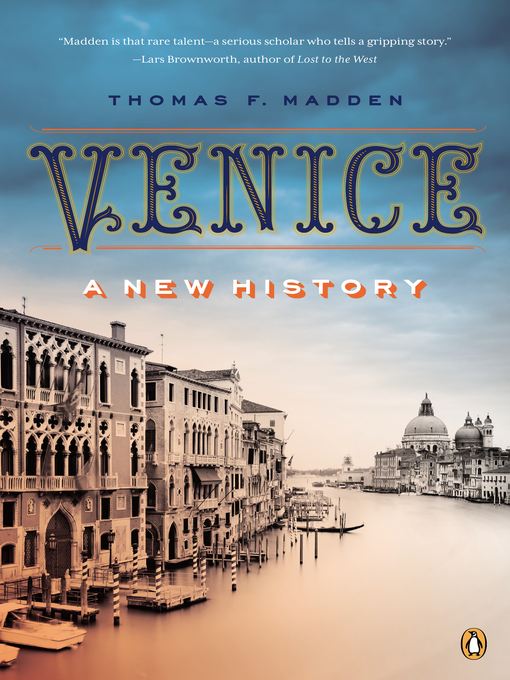
Venice
A New History
کتاب های مرتبط
- اطلاعات
- نقد و بررسی
- دیدگاه کاربران
نقد و بررسی

August 27, 2012
This is a savory, tantalizing, but not-so-serene history of La Serenessimaâa tale of invasion, plunder, and ultimate elevation to one of the leading merchant cities in Europe. As Madden relates, the earliest Venetians were former citizens of the crumbling Roman empire and desperate survivors of Attila the Hun's 452 devastation of such cities as wealthy Aquileia and Patavium. In 697, the scattered lagoon dwellers elected their first "doge" to unify the region. By 810, fledgling Venice was able to repel an invasion by the most powerful force in Europeâthe Frankish king Charlemagne's son Pepin. and in the 11th century, the Norman invasion of Byzantium disrupted Venetian shipping in the Adriatic. But a Venetian war fleet reestablished dominance in the area, and Venice was the second-largest city in western Europe. Its economy damaged by the Fourth Crusade, its population decimated by the bubonic plague, by 1490 Venice had nevertheless reached the pinnacle of its power and with wealth, symbolized by the stunning family palazzi towering over the Grand Canal (although Madden also contends that medieval and Renaissance Venetians are often portrayed unfairly in modern histories as conniving and greedy). St. Louis Univ. history professor Madden's (Empires of Trust) makes use of thousands of Venetians' personal documents from the Middle Ages to present an authoritative history. Agent: J Thornton, The Spieler Agency

September 1, 2012
Solid, informative survey, emphasizing La Serenissima's stature as the world's longest-lived republic and a great commercial power. "The first Venetians were Romans," writes Madden (History and Medieval and Renaissance Studies/St. Louis Univ.; Empires of Trust: How Rome Built--and America Is Building--a New World, 2008, etc.), "proudly refusing to cooperate with a world in collapse." Fleeing fifth-century barbarian invasions of the Italian mainland, they rowed into a lagoon off the Adriatic Sea where they could fish and trade in peace. Its location made Venice a crucial nexus for commerce between Europe and the East, and its leading families valued political stability and a broad-based ruling class. In the post-Roman world of agrarian feudalism, Venice was an urban commercial republic. Its complicated political system would remain unique to Venice, but its financial innovations, from deposit banking to double-entry bookkeeping, were the foundation of modern capitalism. Venice stood at the forefront of world commerce until newly aggressive nation-states like England and France established colonial empires that overshadowed its older, merchant-oriented economy beginning in the 16th century. The fall of Constantinople in 1453 didn't help; Venice had always been a loyal ally of the Byzantine Empire, and the city stood at the front lines for over a century as the Turks repeatedly threatened to invade Europe. Madden admires Venice's conservative elite and defends it as being no more oppressive than any other pre-Enlightenment state. Once the 1,000-year-old republic was forced to surrender to Napoleon in 1797, Madden loses interest and whips briskly through the next two-plus centuries of decay and tourism. Plenty of books focus on Venice the romantic ruin. This one offers a welcome reminder of its historic role over a millennium in the development of a modern economic system and the maintenance of the global balance of power.
COPYRIGHT(2012) Kirkus Reviews, ALL RIGHTS RESERVED.

October 15, 2012
Madden (history, St. Louis Univ.) presents a popular history as engaging as it is solid. In graceful, sometimes elegant prose, he details the long life of one of Europe's most intriguing cities, which survived as a republic for a thousand years. ("It is always crumbling, but it never falls," Venetians are fond of saying.) Though aristocratic in nature, Venice's government was neither closed nor tyrannical; it kept the city stable while other states were in turmoil and held the allegiance of all elements in society. And while Venetians had a reputation for sharp dealing, their reputation for piety was equally well deserved. Madden's description of the process to select a new doge is fascinating: nine bodies, 282 electors in all, were chosen in succession, largely by lot, just to reach the point of nominating the doge. The process wasn't meant to be streamlined. "Quite the opposite," writes Madden, "it was meant to be so cumbersome that only God could influence it." VERDICT This is a bumper year for Venice aficionados: Joanne Ferraro's Venice is for more academic readers but will please serious lay readers. Madden's will satisfy scholars but is intended for an interested lay audience. It is as enjoyable as it is astute.--David Keymer. Modesto, CA
Copyright 2012 Library Journal, LLC Used with permission.

Starred review from October 1, 2012
Founded by bedraggled refugees fleeing the same barbarian invasions that brought the glorious Roman Empire to a close, Venice is a city most of us know for its art and architecture but of whose long, unique history few of us are aware. From its humble beginnings, Venice rose to a position of a naval and economic power as well as a great cultural and intellectual innovator. The Venetian republic, a model for our own, established extensive trading networks, became a maritime juggernaut, and endured the ravages of plague only to see its power gradually eclipsed by the Ottoman Turks and meet its ultimate demise at the hands of a French army. Stepping outside of his usual focus on the Crusades (The New Concise History of the Crusades, 2005), Madden paints a vivid portrait of a city without land, an empire without borders. His engaging work enters a sparse historiography that includes John Julius Norwich's enduring A History of Venice(1982) and Roger Crowley's City of Fortune (2012) and separates itself by offering a readable overview backed by solid research. Readers will come away from Madden's Venice with newfound respect for one of the great jewels of Western civilization.(Reprinted with permission of Booklist, copyright 2012, American Library Association.)

























دیدگاه کاربران